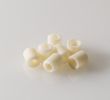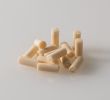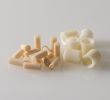Insulating beads and alumina beads
Technical ceramic beads are similar to tubes, capillaries or bifilar beads but much shorter in length. The alumina that makes them up enables them to resist high heat, corrosion and wear. We offer two types of beads in our standard range: ball-and-socket beads, which have a single hole and can be useful to follow a bend without discontinuity of the electrical insulation, and insulating beads, which have two or four holes and are ideal for insulating several cables not only from the external environment, but also from each other. The beads can be obtained by cutting standard capillaries with a diamond saw.
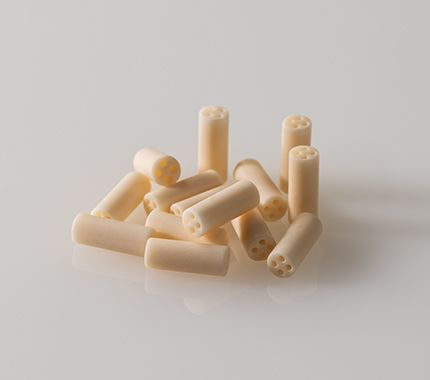
Why choose alumina as a material for ceramic beads?
Alumina is a refractory ceramic material. Indeed, this material resists thermal shocks and temperatures up to 1950 °C for 99.7% pure alumina (DEGUSSIT AL23 for example). In addition, the microstructure of aluminum oxide has excellent dimensional stability, even under the effect of high heat. It is therefore a material of choice for high temperature applications.
On the other hand, alumina is a very good electrical insulator: even at high temperatures, it does not conduct electricity and therefore maintains a significant potential difference between the inside and outside of the ceramic bead, or even between the different holes of the same bead. This makes it possible to insulate cables efficiently.
Finally, alumina is a technical ceramic with a very good resistance to corrosion, abrasion and wear. This allows the utilisation of our alumina beads in any environment (even corrosive), in contact with any product. The very good resistance to wear and tear ensures a long life for our products, making them durable over time: a real asset in terms of economy and safety.
The different sizes of alumina beads we offer -
We offer two ranges of DEGUSSIT AL23 alumina beads: the ball and socket beads and the insulating beads.
The ball joint beads can be used to follow the curvature of a cable. Their external diameter varies from 3.5 mm to 8.5 mm, their internal diameter from 1 mm to 5 mm. The length of these beads evolves with their diameter: from 3 mm to 10 mm.
The insulating beads have fixed diameters in our standard product range. Their inner diameter is 0.8 mm, the outer one is 4 mm. The length of the ceramic beads can be either 4 or 10 mm. We offer beads with different numbers of holes (2 or 4), in order to meet the expectations of our customers according to the number of cables they wish to insulate.
The selling unit of our ceramic beads is the hundred. The price per hundred decreases when the quantity purchased increases. We offer different prices depending on whether the customer buys less than 1000 pieces, more than 1000 pieces, more than 2500 pieces or more than 5000 pieces.
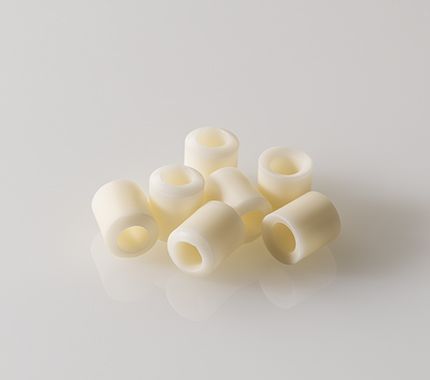
In what fields are ceramic beads used?
Ceramic products in the form of beads can be used for the insulation of electrical cables. Indeed, alumina is a very good electrical insulator which makes it the ideal material for this type of application. Moreover, putting it in the form of pearls allows many freedom as for its utilisation. Indeed, the beads can have several holes, thus allowing, like a capillary to isolate different cables from each other. The fact that they are small pieces (generally shorter than a sheath or a capillary) makes it easier to follow the potential bending of a cable. This possibility is reinforced by the existence of ball-and-socket beads which are ideal to follow the shape of a cable when it is not straight. Aluminum oxide's resistance to corrosion and high temperatures protects cables from external conditions and insulates them eclectically.
Ceramic beads can also be used as sheaths for the protection of thermocouples. Thermocouples are thermal measuring instruments that allow to know the temperature of the surface of an object or in a room. They are often used in industry in industrial ovens (brought to very high temperatures that we want to know precisely) or in the laboratory in the context of research and development. They are based on the Seebeck effect to measure the temperature. The alumina beads can protect the measuring instrument from these extreme temperatures but also from corrosion and abrasion, allowing the thermocouples to be used with any product. They allow to follow a bend more easily than using a sheath.





